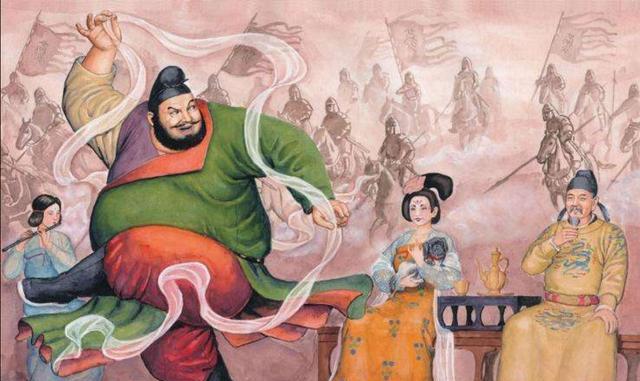Text/Feng Xuanyi
The AnShi Rebellion was a turning point in the history of the Tang Dynasty, and it was also a major event in Chinese history, a rebellion launched by An Lushan and Shi Siming of the Tang Dynasty. There are many articles about the Anshi Rebellion, but many people have not noticed one detail, that is, the racial problem of An Lushan.
The history books say that An Lushan was a "Camp Prefecture bastard", and the reason why it is said is because An Lushan's mother was Turkic, his father died early, and his mother took him to marry a Chestnut general named An Yanyan. However, if you look at cultural identity and living habits, An Lushan should be a Lite, because he grew up in the Lite ethnic group, and his living habits, language, cultural identity, etc. are all Lite people, and everyone around him regards him as a Lite person, and he himself also identifies as a Lite person.

What kind of ethnic group are the Chestnuts?
The Chestnuts are known in ancient texts as the "Nine Surnames of Zhaowu" or "Nine Surnames of Hu", and their homeland is in the Lit region between the Amu Darya and Syr Darya Rivers in Central Asia, centered on Theragan (in present-day Uzbekistan), with nine oasis kingdoms including Kang, An, Cao, Shi, Shi, and Mi. Most of the people of this nation are mainly engaged in business, they are born with the mind and ability to do business, and they are the main bearers of international trade on the Silk Road, and some history books call them "Eastern Phoenicians". In pursuit of wealth, the Chestnuts did not hesitate to leave their homeland, passing through miles of quicksand and the vast Gobi, from the distant Samarkand all the way to the east, to the prosperity of China. As the caravans went, many Sogdians stayed in the area. From the Southern and Northern Dynasties to the Sui and Tang Dynasties, Khotan, Loulan, Guizi, Gaochang, Dunhuang, Jiuquan, Zhangye, Wuwei, Chang'an, Luoyang and other places along the Silk Road were inhabited by Li te people. By the beginning of the New Year, Yingzhou (present-day Chaoyang, Liaoning), where An Lushan grew up, also gathered many Li Te people. The Li te people have been practicing riding and shooting since childhood, and they are brave warriors, so the Li Te people in the Yingzhou area have a great influence.
An Lushan, who lives in the Lite ethnic group, has been brave and good at war since he was a child, and can speak nine languages and communicate fluently with people of different ethnic groups. This laid a solid foundation for his development in the Yingzhou area.
In addition, the Chestnuts practice Zoroastrianism. Zoroastrianism, also known as Zoroastrianism, was introduced to China from Persia in the last years of the Western Jin Dynasty, and its name in Persia is "Zoroastrianism", which mainly worships the god of light.
An Lushan was deeply influenced by Zoroastrianism, and his original name, Ginshan, was a transliteration of the Sogdian word for "light". An Lushan made full use of Zoroastrianism to unite the Hu people in the Yingzhou area. After he gained power, he continued to deify himself by using Zoroastrianism, and he molded himself into the embodiment of the "God of Light", so that the Hu people around him were closely united around him, thus forming a close group. In this group, in addition to An Lushan, the most important general was Shi Siming. Shi Siming's origins and experiences are similar to An Lushan's, and he grew up among the Chestnut people. In addition, there were a large number of Sogdian warriors such as He Qiannian, An Taiqing, An Shouzhong, Kang Jie, and An Wuchen, who were loyal to An Lushan and became important generals in the anshi rebellion in the future.
According to the "Deeds of An Lushan", when An Lushan served as the envoy of Fanyang Festival, he often sent Sogdian Hu people to do business throughout the country, and shipped a large amount of gold and silver jewelry back to Fanyang every year. Whenever these Hu merchants returned to offer treasures, An Lushan always held a solemn ceremony, dressed in the traditional costumes of the Sogdian people, sitting on a high bed, listing the treasures in front, while the cigarettes were swirling, the wizards were beating drums and singing, and the Hu people were worshiping below and praying to the heavens.
Although An Lushan was a general of the Tang Dynasty, he also led the three towns as an envoy. However, his core group was still composed of The Chestnuts, who did not recognize the imperial court, but only An Lushan. An Lushan was to closely unite the Lite people through ethnic groups, religions, etc., and form an armed force that could resist the imperial court.
On November 9, the fourteenth year of Tianbao (755), An Lushan, who had long been dissident, raised an army at Fanyang, and the An Shi Rebellion broke out.